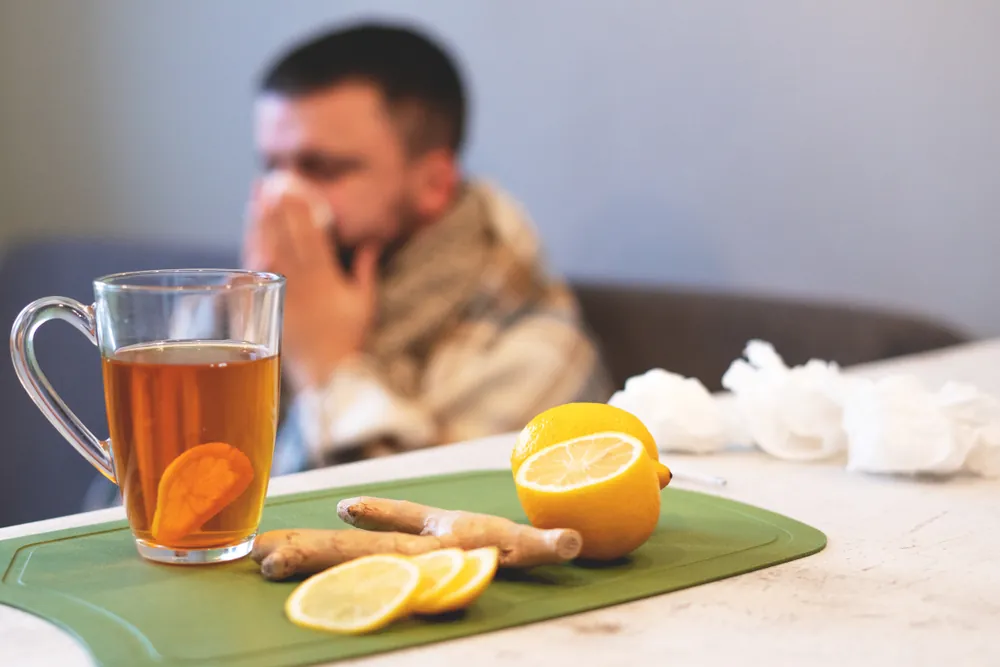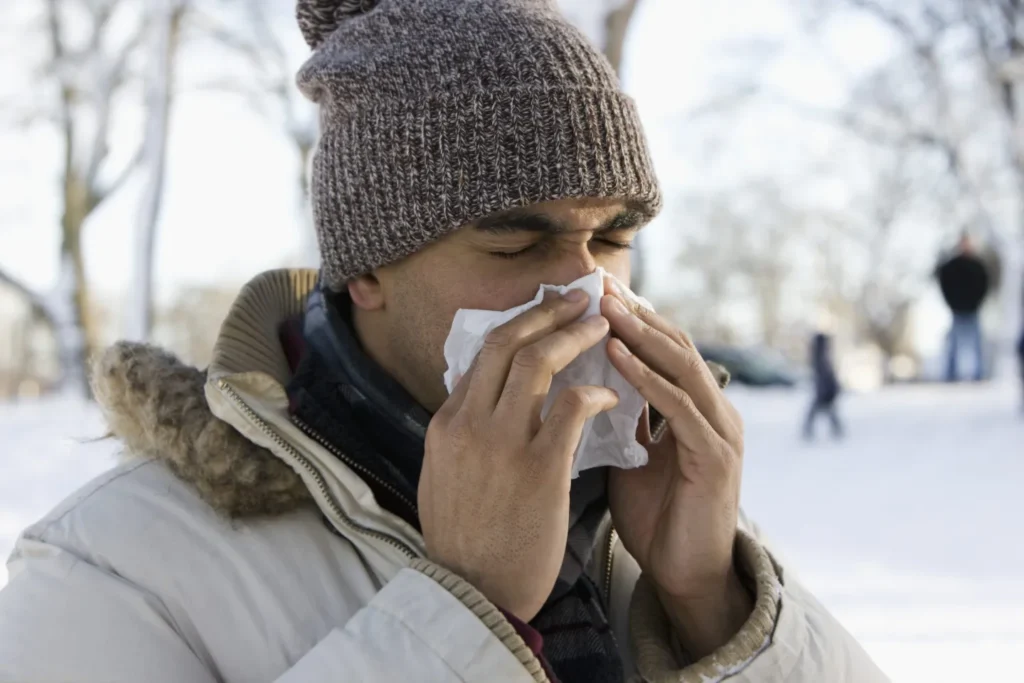Wondering how to stay healthy during cold and flu season? You’re not alone! Every year, as the leaves fall and temperatures drop, the risk of catching a cold or flu rises—especially where people work, study, or gather closely indoors. The great news: with simple habits, natural remedies, and proactive wellness strategies, you can dramatically lower your risk of getting sick and support faster recovery if you do catch something.
This comprehensive guide covers everything you need to know about how to stay healthy during cold and flu season—from daily prevention to natural immune boosters, symptom relief, and home care strategies for families and individuals.
Understanding Cold and Flu Season Risks
Why Are Colds and the Flu So Common in the Fall and Winter?
- Viruses like rhinovirus and influenza survive longer in cold, dry air.
- Indoor heating dries out your nasal passages, making virus transmission easier.
- People spend more time together inside, sharing air and surfaces.
Who’s Most at Risk?
- Children, seniors, and anyone with a weakened immune system
- People with chronic conditions, such as diabetes or asthma
- Those who work in public settings or commute via crowded transportation
How to Stay Healthy During Cold and Flu Season: Core Principles
Prioritize Good Hygiene
- Wash Hands Frequently: Scrub hands with soap and water for at least 20 seconds, especially before meals and after public outings.
- Avoid Touching Your Face: Virus particles enter through your eyes, nose, and mouth.
- Disinfect High-Touch Surfaces: Clean doorknobs, remote controls, phones, and keyboards regularly.
Support Your Immune System
- Eat a Balanced Diet: Emphasize colorful vegetables, whole grains, lean proteins, and healthy fats.
- Stay Hydrated: Aim for at least 8 glasses of water or herbal tea each day.
- Get Enough Sleep: Adults need 7–9 hours; sleep is your immune system’s best repair tool.
- Stay Active: Moderate exercise helps immune cells circulate and perform better.
- Manage Stress: Chronic stress suppresses immune function—practice meditation, deep breathing, or journaling.
Natural Ways to Prevent Colds and Flu at Home

Optimize Your Daily Routines
- Start Each Morning with Warm Lemon Water: Helps hydrate, provides vitamin C, and supports digestion.
- Use a Humidifier: Moist air prevents your nasal passages from drying out and reduces risk of infection1.
Herbal and Dietary Supplements
| Natural Remedy | How It Helps | How to Use |
|---|---|---|
| Vitamin C | May shorten duration of illness, supports immunity | Citrus fruits, peppers, broccoli, supplements1 |
| Zinc | May reduce risk and length of colds | Lozenges, shellfish, beans78 |
| Probiotics | Supports gut and overall immunity | Yogurt with live cultures, kefir, supplements1 |
| Echinacea | May help reduce severity or likelihood of colds | Tea or supplement (short-term) 12 |
| Garlic | Antimicrobial, immune-boosting | Add raw or cooked garlic to meals12 |
| Green tea | Antioxidants, may enhance immune response | Hot or iced, with lemon3 |
Note: Talk to your healthcare professional before starting new supplements, especially if you have a health condition or take medication.
Protective Home Practices
- Gargle With Salt Water: May reduce throat soreness and help prevent upper respiratory infections1.
- Ventilate Your Home: Open windows for a few minutes daily to circulate fresh air.
- Disinfect Surfaces: Wipe down kitchen counters, bathrooms, and electronics frequently.
How to Stay Healthy During Cold and Flu Season: Practical Daily Tips
Smart Nutrition Choices
- Fill half your plate with non-starchy veggies at lunch and dinner.
- Include vitamin-rich foods daily: orange, bell peppers, spinach, or kale.
- Snack on nuts, seeds, or yogurt instead of sugary treats.
- Limit processed foods and added sugars, which may inflame the body.
Physical Activity
- Do at least 20–30 minutes of walking, stretching, or cycling 4–5 times per week.
- If it’s cold outside, try home workouts (like squats, dancing, or yoga).
Rest and Recovery
- Stick to regular sleep and wake times (even on weekends).
- Wind down screens and bright lights at least 30 minutes before bed.
How to Support Children and Seniors During Cold and Flu Season

Kids
- Teach proper handwashing and covering sneezes with elbows.
- Send hand sanitizer for school or outings.
- Make healthy eating fun with “rainbow salads” and fruit smoothies.
- Dress them in layers to avoid sudden chills.
Seniors
- Check with a doctor about annual flu shots and pneumococcal vaccines.
- Ensure they drink enough fluids—even mild dehydration increases risk.
- Help keep living spaces clean and free from excess clutter and dust.
Responding to the First Signs of Illness
Early Intervention
- Start drinking extra fluids—warm teas, broths, and water.
- Rest as soon as you feel symptoms coming on; don’t “push through” severe fatigue.
- Use saline nasal spray or a humidifier to ease congestion.
- Isolate from family when possible to prevent spreading germs.
Home Remedies for Symptom Relief
- Honey and ginger tea: Soothes sore throat and cough1210.
- Steam inhalation: Eases mucus and congestion.
- Chicken soup: Traditional remedy that supports hydration and nutrition1.
- Menthol and essential oils: Eases stuffiness when used in vapor rubs or steam, but avoid direct application on young kids26.
Myths & Facts About Staying Healthy During Cold and Flu Season
| Myth | What’s True |
|---|---|
| “Vitamin C alone prevents all colds” | It may support immunity, but isn’t a guarantee1. |
| “Antibiotics cure the flu” | Flu is viral—antibiotics only work on bacteria. |
| “You catch cold from cold air” | Viruses, not temperature, cause illness. |
| “Natural remedies are always safe” | Some can cause side effects or interact with meds; consult your doctor2. |
Frequently Asked Questions: How to Stay Healthy During Cold and Flu Season
1. Should I take supplements during cold and flu season?
Supplements like vitamin C, D, zinc, or probiotics may help some people, but the best approach is a balanced diet with plenty of immune-supportive foods. Consult your healthcare provider before adding supplements, especially for children or those with chronic conditions128.
2. How can I tell if it’s a cold, the flu, or something else?
Colds usually have milder symptoms (runny nose, sore throat, mild cough). The flu often comes on suddenly with fever, chills, muscle aches, and more severe fatigue. Call a healthcare provider if you’re unsure or if symptoms are intense.
3. Should I get a flu shot?
Most healthcare providers recommend annual flu vaccination, especially for those at increased risk. It’s a safe, effective way to reduce the chance of severe illness.
4. Is it safe to exercise while feeling under the weather?
Gentle activity is fine for mild symptoms (runny nose, no fever), but take full rest if you have a fever, chest pain, or significant fatigue.
Additional Tips for How to Stay Healthy During Cold and Flu Season
Mindfulness and Stress Management
- Try meditation, breathing exercises, or creative activities to lower stress hormones.
- Laugh often—laughter supports immune function!
Social Considerations
- Politely avoid handshakes; opt for a wave or “elbow bump.”
- Stay home if you feel sick to protect others.
- Wear a mask in crowded indoor settings if cold or flu is going around.
When to See a Doctor
- Symptoms last more than 10 days or worsen suddenly.
- High fever, shortness of breath, severe dehydration, or confusion occur.
- For infants, elderly, or those with chronic conditions, seek help earlier.
Key Takeaways: Mastering How to Stay Healthy During Cold and Flu Season
- Wash hands, hydrate, and get enough sleep every day.
- Eat real food—especially fruits and vegetables rich in vitamins and antioxidants.
- Use natural home remedies and manage your stress for added benefit.
- Stay informed, act at the first sign of illness, and know when to seek medical care.
The Science of Immunity: How Your Body Fights Colds and Flu
Understanding Your Immune System’s Defenses
Your immune system is a complex network designed to fend off viruses and bacteria. When considering how to stay healthy during cold and flu season, it helps to know how these natural defenses work.
- Innate immunity is your body’s first line of defense, involving skin, mucous membranes, and immune cells that recognize and attack anything foreign.
- Adaptive immunity involves specialized cells (T-cells and B-cells) that remember past invaders and mount a faster, stronger response when the same virus is encountered again.
Factors That Influence Immunity
- Genetics: Some people naturally have more robust immune responses, but environment and habits play a big role.
- Chronic Stress: Prolonged anxiety and high cortisol levels weaken immune response and make you more susceptible.
- Age: Our ability to fight infection declines with age, so kids and elders are at higher risk.
Understanding this helps you appreciate the value of every preventive step you take during cold and flu season.
Holistic Strategies: Supporting Whole-Person Wellness
Integrating Mind, Body, and Environment

True wellness during cold and flu season means more than just avoiding germs. Consider these complementary strategies:
1. Sleep as Medicine
Quality rest allows the body to repair and keep immune cells functioning. Try:
- Sticking to a sleep schedule, even on weekends.
- Creating a wind-down ritual with reading or gentle music before bed.
- Avoiding screens one hour before sleep to improve melatonin production.
2. Advanced Stress Relief
Chronic stress suppresses immune function. Boost your resilience with:
- Guided meditation or deep breathing apps.
- Journaling three things you’re grateful for before bed.
- Spending time in nature to lower cortisol, even if it’s a quick walk outside.
3. Nurture Social Connection
Human connection and laughter have measurable effects on immunity! Try:
- Scheduling a virtual game night or tea with friends—even short, positive interactions lift immune health.
- Volunteering remotely or sending encouragement notes to others in your community.
Creating a Health-Optimized Home Environment
Environmental Adjustments for Optimal Health
Your surroundings play a massive role in how to stay healthy during cold and flu season. Make your home a health haven:
1. Air Quality and Ventilation
- Invest in a quality HEPA air filter to reduce airborne viruses, dust, and allergens.
- Regularly air out rooms—even in winter—by opening windows for a few minutes daily.
- Use plants like spider plants or peace lilies to help purify indoor air.
2. Humidity Control
- Keep the humidity in your home between 40–60%.
- Dry air can dry out your nasal passages (making viruses easier to catch), while too much moisture can encourage mold.
- Use a hygrometer to monitor levels and adjust humidifiers as needed.
3. Surface Hygiene Routine
- Assign disinfecting tasks to family members (door handles, remotes, light switches).
- Rotate through eco-friendly cleaners made with vinegar or hydrogen peroxide for regular cleaning.
- Launder bedding and towels weekly in hot water.
Navigating Work and School During Cold and Flu Season

Proactive Tips for On-the-Go Wellness
If you’re working in an office, attending school, or sending your kids to class, add these layers of protection:
1. Workplace Safety Strategies
- Sanitize your workspace daily—desk, phone, keyboard, and mouse.
- Keep a small bottle of hand sanitizer at your workstation and use after touching public resources like printers or doorknobs.
- Advocate for sick leave or remote work if symptomatic.
2. Healthy School Habits for Kids
- Put spare masks and pocket-sized hand sanitizer in backpacks.
- Add immune-boosting foods to school lunches: citrus slices, bell pepper strips, and low-sugar yogurt cups.
- Teach your child to avoid sharing water bottles or utensils.
3. Smart Commute Habits
- On public transit, avoid touching your face and, if possible, wear a mask during high-risk seasons.
- Consider wearing gloves or using a tissue to grip handrails.
Traveling During Cold and Flu Season: Advanced Self-Protection
Safe Travel Tips for Business, Holidays, or Family Visits
Travel exposes you to many new germs. Here’s how to stay healthy during cold and flu season on the move:
- Prepare a Portable Wellness Kit:
- Travel-size tissues, hand sanitizer, disinfectant wipes, and masks.
- Herbal tea bags (like ginger or chamomile) for hotel rooms.
- Wipe Down Surfaces:
- Clean armrests, tray tables, and seatbelt buckles on planes, trains, and buses.
- Stay Hydrated in Dry Environments:
- Drink extra water to compensate for dry air in planes.
- Pack Immunity-Friendly Snacks:
- Raw nuts, seed mixes, dried fruit, and vitamin C-rich bars.
- Rest and Recover:
- Allow travel time for sleep and gentle stretching—don’t book yourself too tightly.
Community Immunity: Helping Others Stay Healthy Too
Simple Actions That Support the Health of Everyone
- Promote “Stay Home When Sick”:
- Encourage friends, colleagues, and employees to recover fully before returning.
- Share Wise Tips:
- Organize a “wellness bulletin” for your neighborhood or workplace.
- Host a Virtual Immune-Boosting Cooking Party:
- Share recipes for vitamin-packed soups or teas.
Setting the Example
Be a “wellness ambassador” by modeling—handwashing, covering coughs, eating well—which sets the tone for those around you.
Advanced FAQ: Expert Answers for How to Stay Healthy During Cold and Flu Season

Do probiotics really help prevent colds and flus?
Yes, increasing research suggests that a healthy gut boosts immune defenses by supporting antibody production and reducing inflammation.
Can I “boost” my immune system with supplements?
Supplements may help fill nutritional gaps, but no pill can replace a diet of whole foods, regular movement, and good sleep.
Is there a best time to get a flu shot?
Aim for early autumn, before peak flu season, to give your immune system time to build protection.
What should I do if someone in my household gets sick?
Designate a “sick room,” use separate towels, wash hands after any contact, and disinfect shared surfaces daily.
Comprehensive Cold and Flu Wellness Checklist
- Wash and sanitize hands before eating or touching your face.
- Get 7–9 hours of sleep nightly.
- Drink at least 8 cups of water.
- Eat a variety of colored fruits and vegetables each day.
- Take movement or stretch breaks every hour if working/studying from home.
- Change and launder bed linens weekly.
- Open windows for 5–10 minutes daily for fresh air.
- Wipe down your phone, keys, and door handles every day.
- Proactively support and encourage sick friends, family, or coworkers to rest.
Final Thoughts: Embracing a Whole-Season Approach
Thriving through cold and flu season isn’t about a single trick, but a daily commitment to balanced wellness. When you combine science-backed habits, environmental improvements, and a proactive mindset, you’re empowered to support your health and the health of your community. Begin integrating these advanced strategies today, and enjoy a vibrant, resilient season!
